Te Tiriti o Waitangi: Socio-cultural Factors Impacting Health Outcomes
VerifiedAdded on 2023/06/15
|10
|2317
|216
Homework Assignment
AI Summary
This assignment delves into the socio-cultural and historical factors influencing health and wellbeing in New Zealand, with a particular focus on the impact of colonization and the Treaty of Waitangi. It examines the historical factors affecting Māori health, such as the signing of the Treaty in different languages, land confiscations, and the formation of the Native Land Court. The assignment further analyzes the social and historical factors impacting Pacific Peoples' health, including cultural changes, identity conflicts, and limited access to education and employment. Additionally, it explores the challenges faced by other migrant groups in New Zealand, such as integration difficulties, discrimination, and healthcare access. The assignment also applies the Te Whare Tapa Whā model to assess how these factors affect different dimensions of health. Finally, it reflects on personal values and how they influence engagement with others, considering cultural, social, and emotional factors in interpersonal interactions.

Socio-cultural and
Historical Factors
Influencing Health
and Wellbeing
ABSTRACT
When considering own culture we also capture
the history of NZ Culture and the impact this has
had on health and wellbeing. As a critical part of
this learning module we have Links for you to
access and a thought provoking video called
‘Nga Tohu signatures’. The video is set within a
fictional community of Onehora, New Zealand
during the period 1839-1840. The historic story
looks at why the Treaty of Waitangi was signed
and what it meant to both Crown and Māori.
Historical Factors
Influencing Health
and Wellbeing
ABSTRACT
When considering own culture we also capture
the history of NZ Culture and the impact this has
had on health and wellbeing. As a critical part of
this learning module we have Links for you to
access and a thought provoking video called
‘Nga Tohu signatures’. The video is set within a
fictional community of Onehora, New Zealand
during the period 1839-1840. The historic story
looks at why the Treaty of Waitangi was signed
and what it meant to both Crown and Māori.
Paraphrase This Document
Need a fresh take? Get an instant paraphrase of this document with our AI Paraphraser
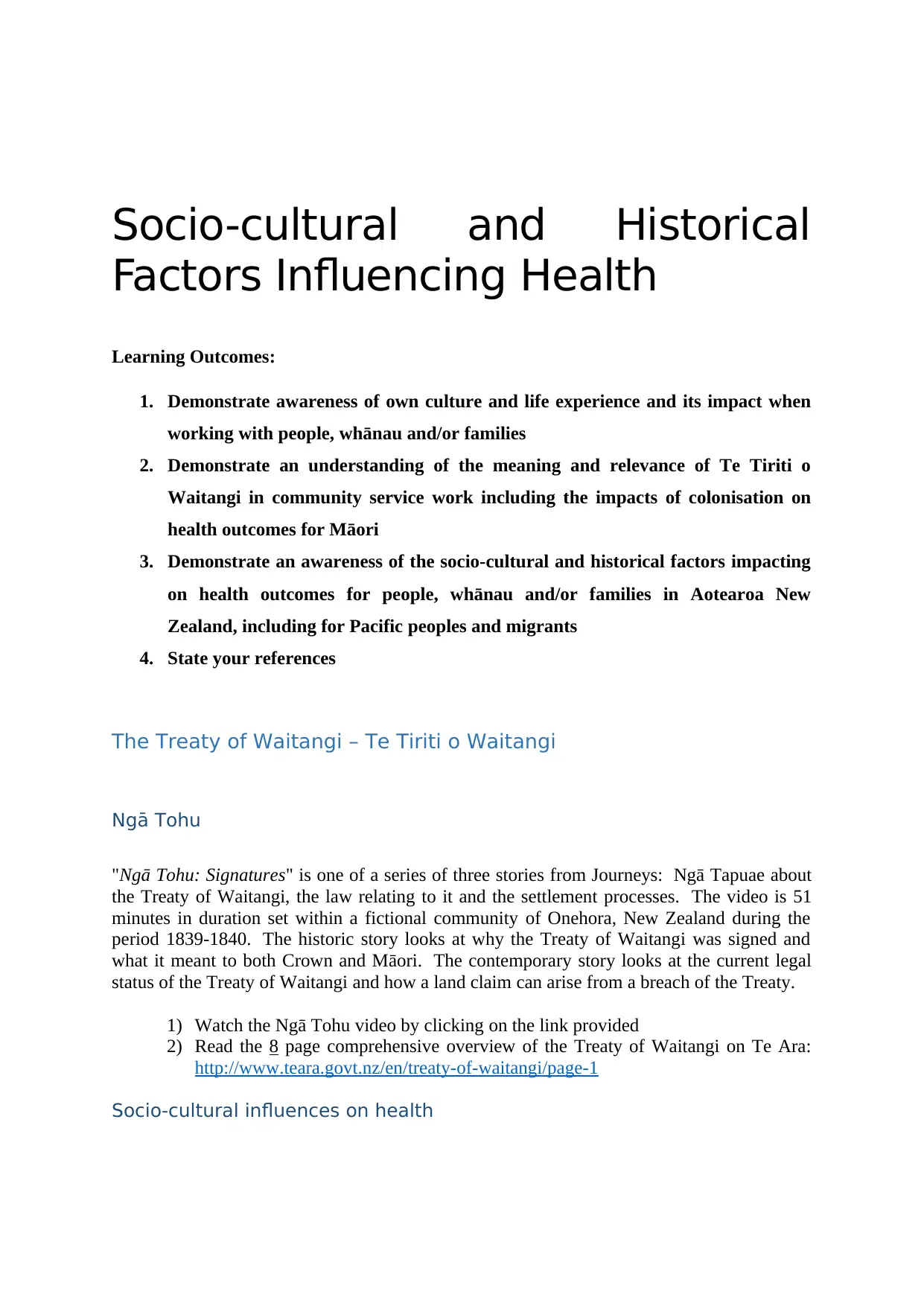
Socio-cultural and Historical
Factors Influencing Health
Learning Outcomes:
1. Demonstrate awareness of own culture and life experience and its impact when
working with people, whānau and/or families
2. Demonstrate an understanding of the meaning and relevance of Te Tiriti o
Waitangi in community service work including the impacts of colonisation on
health outcomes for Māori
3. Demonstrate an awareness of the socio-cultural and historical factors impacting
on health outcomes for people, whānau and/or families in Aotearoa New
Zealand, including for Pacific peoples and migrants
4. State your references
The Treaty of Waitangi – Te Tiriti o Waitangi
Ngā Tohu
"Ngā Tohu: Signatures" is one of a series of three stories from Journeys: Ngā Tapuae about
the Treaty of Waitangi, the law relating to it and the settlement processes. The video is 51
minutes in duration set within a fictional community of Onehora, New Zealand during the
period 1839-1840. The historic story looks at why the Treaty of Waitangi was signed and
what it meant to both Crown and Māori. The contemporary story looks at the current legal
status of the Treaty of Waitangi and how a land claim can arise from a breach of the Treaty.
1) Watch the Ngā Tohu video by clicking on the link provided
2) Read the 8 page comprehensive overview of the Treaty of Waitangi on Te Ara:
http://www.teara.govt.nz/en/treaty-of-waitangi/page-1
Socio-cultural influences on health
Factors Influencing Health
Learning Outcomes:
1. Demonstrate awareness of own culture and life experience and its impact when
working with people, whānau and/or families
2. Demonstrate an understanding of the meaning and relevance of Te Tiriti o
Waitangi in community service work including the impacts of colonisation on
health outcomes for Māori
3. Demonstrate an awareness of the socio-cultural and historical factors impacting
on health outcomes for people, whānau and/or families in Aotearoa New
Zealand, including for Pacific peoples and migrants
4. State your references
The Treaty of Waitangi – Te Tiriti o Waitangi
Ngā Tohu
"Ngā Tohu: Signatures" is one of a series of three stories from Journeys: Ngā Tapuae about
the Treaty of Waitangi, the law relating to it and the settlement processes. The video is 51
minutes in duration set within a fictional community of Onehora, New Zealand during the
period 1839-1840. The historic story looks at why the Treaty of Waitangi was signed and
what it meant to both Crown and Māori. The contemporary story looks at the current legal
status of the Treaty of Waitangi and how a land claim can arise from a breach of the Treaty.
1) Watch the Ngā Tohu video by clicking on the link provided
2) Read the 8 page comprehensive overview of the Treaty of Waitangi on Te Ara:
http://www.teara.govt.nz/en/treaty-of-waitangi/page-1
Socio-cultural influences on health
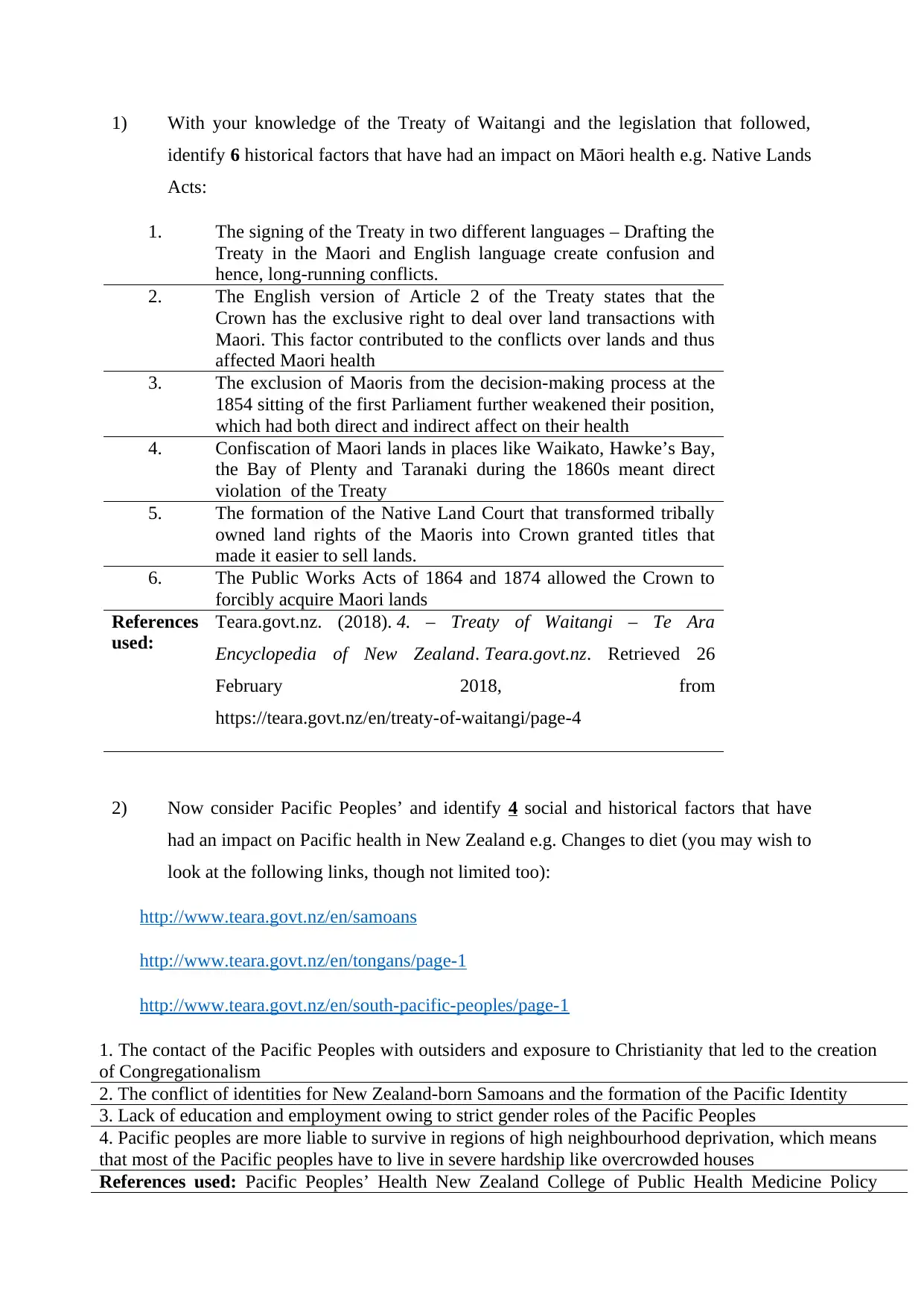
1) With your knowledge of the Treaty of Waitangi and the legislation that followed,
identify 6 historical factors that have had an impact on Māori health e.g. Native Lands
Acts:
1. The signing of the Treaty in two different languages – Drafting the
Treaty in the Maori and English language create confusion and
hence, long-running conflicts.
2. The English version of Article 2 of the Treaty states that the
Crown has the exclusive right to deal over land transactions with
Maori. This factor contributed to the conflicts over lands and thus
affected Maori health
3. The exclusion of Maoris from the decision-making process at the
1854 sitting of the first Parliament further weakened their position,
which had both direct and indirect affect on their health
4. Confiscation of Maori lands in places like Waikato, Hawke’s Bay,
the Bay of Plenty and Taranaki during the 1860s meant direct
violation of the Treaty
5. The formation of the Native Land Court that transformed tribally
owned land rights of the Maoris into Crown granted titles that
made it easier to sell lands.
6. The Public Works Acts of 1864 and 1874 allowed the Crown to
forcibly acquire Maori lands
References
used:
Teara.govt.nz. (2018). 4. – Treaty of Waitangi – Te Ara
Encyclopedia of New Zealand. Teara.govt.nz. Retrieved 26
February 2018, from
https://teara.govt.nz/en/treaty-of-waitangi/page-4
2) Now consider Pacific Peoples’ and identify 4 social and historical factors that have
had an impact on Pacific health in New Zealand e.g. Changes to diet (you may wish to
look at the following links, though not limited too):
http://www.teara.govt.nz/en/samoans
http://www.teara.govt.nz/en/tongans/page-1
http://www.teara.govt.nz/en/south-pacific-peoples/page-1
1. The contact of the Pacific Peoples with outsiders and exposure to Christianity that led to the creation
of Congregationalism
2. The conflict of identities for New Zealand-born Samoans and the formation of the Pacific Identity
3. Lack of education and employment owing to strict gender roles of the Pacific Peoples
4. Pacific peoples are more liable to survive in regions of high neighbourhood deprivation, which means
that most of the Pacific peoples have to live in severe hardship like overcrowded houses
References used: Pacific Peoples’ Health New Zealand College of Public Health Medicine Policy
identify 6 historical factors that have had an impact on Māori health e.g. Native Lands
Acts:
1. The signing of the Treaty in two different languages – Drafting the
Treaty in the Maori and English language create confusion and
hence, long-running conflicts.
2. The English version of Article 2 of the Treaty states that the
Crown has the exclusive right to deal over land transactions with
Maori. This factor contributed to the conflicts over lands and thus
affected Maori health
3. The exclusion of Maoris from the decision-making process at the
1854 sitting of the first Parliament further weakened their position,
which had both direct and indirect affect on their health
4. Confiscation of Maori lands in places like Waikato, Hawke’s Bay,
the Bay of Plenty and Taranaki during the 1860s meant direct
violation of the Treaty
5. The formation of the Native Land Court that transformed tribally
owned land rights of the Maoris into Crown granted titles that
made it easier to sell lands.
6. The Public Works Acts of 1864 and 1874 allowed the Crown to
forcibly acquire Maori lands
References
used:
Teara.govt.nz. (2018). 4. – Treaty of Waitangi – Te Ara
Encyclopedia of New Zealand. Teara.govt.nz. Retrieved 26
February 2018, from
https://teara.govt.nz/en/treaty-of-waitangi/page-4
2) Now consider Pacific Peoples’ and identify 4 social and historical factors that have
had an impact on Pacific health in New Zealand e.g. Changes to diet (you may wish to
look at the following links, though not limited too):
http://www.teara.govt.nz/en/samoans
http://www.teara.govt.nz/en/tongans/page-1
http://www.teara.govt.nz/en/south-pacific-peoples/page-1
1. The contact of the Pacific Peoples with outsiders and exposure to Christianity that led to the creation
of Congregationalism
2. The conflict of identities for New Zealand-born Samoans and the formation of the Pacific Identity
3. Lack of education and employment owing to strict gender roles of the Pacific Peoples
4. Pacific peoples are more liable to survive in regions of high neighbourhood deprivation, which means
that most of the Pacific peoples have to live in severe hardship like overcrowded houses
References used: Pacific Peoples’ Health New Zealand College of Public Health Medicine Policy
⊘ This is a preview!⊘
Do you want full access?
Subscribe today to unlock all pages.

Trusted by 1+ million students worldwide

Statement. (2018). Nzcphm.org.nz. Retrieved 26 February 2018, from
https://www.nzcphm.org.nz/media/87942/2015_08_14_pacific_peoples__health_policy_stateme
nt.pdf
Teara.govt.nz. (2018). 5. – Pacific Island health – Te Ara Encyclopedia of New Zealand. Teara.govt.nz.
Retrieved 26 February 2018, from https://teara.govt.nz/en/pacific-island-health/page-5
3) Finally, consider other migrant groups to New Zealand. Identify 4 social and
historical factors that have had an impact on migrant health in New Zealand e.g. Loss
of culture
1. The integration of different migrant groups with New Zealanders affected
in the loss of identity
2. Discrimination against the different migrant groups like Tongans, Samoas
and Kiribatis by mainland people
3. Lack of access to central healthcare system
4 Lack of proper education for migrant groups thus resulting in ignorance and
awareness about health issues and rights.
References used: Ncbi.nlm.nih.gov. (2018). Retrieved 26 February 2018,
from https://www.ncbi.nlm.nih.gov/pmc/articles/PMC1470538/
Teara.govt.nz. (2018). 2. – South Pacific peoples – Te Ara Encyclopedia of
New Zealand. Teara.govt.nz. Retrieved 26 February 2018, from
https://teara.govt.nz/en/south-pacific-peoples/page-2
Te Whare Tapa Whā
One of the most utilised Māori models of health in New Zealand is Te Whare Tapa Whā – the
four sides of the meeting house. Mason Durie developed Te Whare Tapa Whā in 1985 in an
attempt to highlight the differences between Māori and Western perspectives on health. The
model has since been utilised across the health, education, and justice sectors (Cherrington,
2009).
https://www.nzcphm.org.nz/media/87942/2015_08_14_pacific_peoples__health_policy_stateme
nt.pdf
Teara.govt.nz. (2018). 5. – Pacific Island health – Te Ara Encyclopedia of New Zealand. Teara.govt.nz.
Retrieved 26 February 2018, from https://teara.govt.nz/en/pacific-island-health/page-5
3) Finally, consider other migrant groups to New Zealand. Identify 4 social and
historical factors that have had an impact on migrant health in New Zealand e.g. Loss
of culture
1. The integration of different migrant groups with New Zealanders affected
in the loss of identity
2. Discrimination against the different migrant groups like Tongans, Samoas
and Kiribatis by mainland people
3. Lack of access to central healthcare system
4 Lack of proper education for migrant groups thus resulting in ignorance and
awareness about health issues and rights.
References used: Ncbi.nlm.nih.gov. (2018). Retrieved 26 February 2018,
from https://www.ncbi.nlm.nih.gov/pmc/articles/PMC1470538/
Teara.govt.nz. (2018). 2. – South Pacific peoples – Te Ara Encyclopedia of
New Zealand. Teara.govt.nz. Retrieved 26 February 2018, from
https://teara.govt.nz/en/south-pacific-peoples/page-2
Te Whare Tapa Whā
One of the most utilised Māori models of health in New Zealand is Te Whare Tapa Whā – the
four sides of the meeting house. Mason Durie developed Te Whare Tapa Whā in 1985 in an
attempt to highlight the differences between Māori and Western perspectives on health. The
model has since been utilised across the health, education, and justice sectors (Cherrington,
2009).
Paraphrase This Document
Need a fresh take? Get an instant paraphrase of this document with our AI Paraphraser
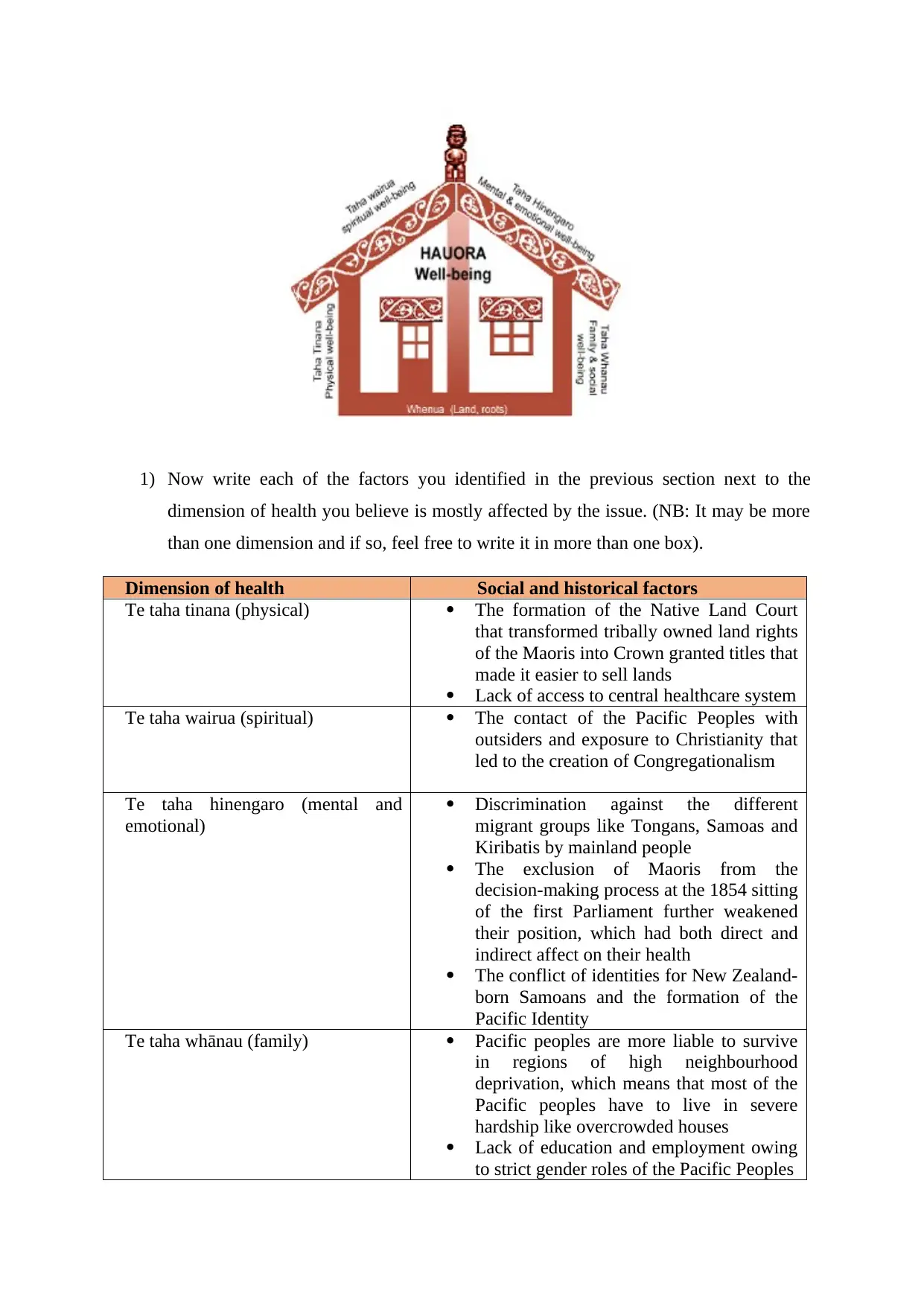
1) Now write each of the factors you identified in the previous section next to the
dimension of health you believe is mostly affected by the issue. (NB: It may be more
than one dimension and if so, feel free to write it in more than one box).
Dimension of health Social and historical factors
Te taha tinana (physical) The formation of the Native Land Court
that transformed tribally owned land rights
of the Maoris into Crown granted titles that
made it easier to sell lands
Lack of access to central healthcare system
Te taha wairua (spiritual) The contact of the Pacific Peoples with
outsiders and exposure to Christianity that
led to the creation of Congregationalism
Te taha hinengaro (mental and
emotional)
Discrimination against the different
migrant groups like Tongans, Samoas and
Kiribatis by mainland people
The exclusion of Maoris from the
decision-making process at the 1854 sitting
of the first Parliament further weakened
their position, which had both direct and
indirect affect on their health
The conflict of identities for New Zealand-
born Samoans and the formation of the
Pacific Identity
Te taha whānau (family) Pacific peoples are more liable to survive
in regions of high neighbourhood
deprivation, which means that most of the
Pacific peoples have to live in severe
hardship like overcrowded houses
Lack of education and employment owing
to strict gender roles of the Pacific Peoples
dimension of health you believe is mostly affected by the issue. (NB: It may be more
than one dimension and if so, feel free to write it in more than one box).
Dimension of health Social and historical factors
Te taha tinana (physical) The formation of the Native Land Court
that transformed tribally owned land rights
of the Maoris into Crown granted titles that
made it easier to sell lands
Lack of access to central healthcare system
Te taha wairua (spiritual) The contact of the Pacific Peoples with
outsiders and exposure to Christianity that
led to the creation of Congregationalism
Te taha hinengaro (mental and
emotional)
Discrimination against the different
migrant groups like Tongans, Samoas and
Kiribatis by mainland people
The exclusion of Maoris from the
decision-making process at the 1854 sitting
of the first Parliament further weakened
their position, which had both direct and
indirect affect on their health
The conflict of identities for New Zealand-
born Samoans and the formation of the
Pacific Identity
Te taha whānau (family) Pacific peoples are more liable to survive
in regions of high neighbourhood
deprivation, which means that most of the
Pacific peoples have to live in severe
hardship like overcrowded houses
Lack of education and employment owing
to strict gender roles of the Pacific Peoples

Whānaungatanga
Whanaungatanga is a key concept to Māori relationships and can be defined as the way in
which engagement, connections, obligations and responsibilities between people are
identified and strengthened (Macfarlane as cited in Berryman, SooHoo and Nevin, 2013).
In order to connect effectively with others, it is important to have an understanding of who
you are and what is important to you.
The following activity gives you an opportunity to consider these things. Consider and write
a response to the following questions:
1) How would I describe myself?
A general description of me would include my family and my ethnicity. I am a New
Zealander with ancestral linkages to the British. I am practicing health care studies
and aspire to become a health professional. I am outspoken and clear-headed. I
believe in honesty and hate people who fake or pretend to be what they are not.
2) What is important to me?
My family is important to me. When it comes to ideology, giving and earning respect
is very important for me. Understanding the pain of others, being compassionate and
enthusiastic to serve people without any self-interest also hold important place for me.
3) How do others know what is important to me?
Others have observed me in my life and that is how they know what is important to
me and as I have already asserted, I am outspoken and thus, it might have given others
the idea as to the kind of a person I am and the things that hold value for me.
4) Who influences the decisions I make in my life?
Whanaungatanga is a key concept to Māori relationships and can be defined as the way in
which engagement, connections, obligations and responsibilities between people are
identified and strengthened (Macfarlane as cited in Berryman, SooHoo and Nevin, 2013).
In order to connect effectively with others, it is important to have an understanding of who
you are and what is important to you.
The following activity gives you an opportunity to consider these things. Consider and write
a response to the following questions:
1) How would I describe myself?
A general description of me would include my family and my ethnicity. I am a New
Zealander with ancestral linkages to the British. I am practicing health care studies
and aspire to become a health professional. I am outspoken and clear-headed. I
believe in honesty and hate people who fake or pretend to be what they are not.
2) What is important to me?
My family is important to me. When it comes to ideology, giving and earning respect
is very important for me. Understanding the pain of others, being compassionate and
enthusiastic to serve people without any self-interest also hold important place for me.
3) How do others know what is important to me?
Others have observed me in my life and that is how they know what is important to
me and as I have already asserted, I am outspoken and thus, it might have given others
the idea as to the kind of a person I am and the things that hold value for me.
4) Who influences the decisions I make in my life?
⊘ This is a preview!⊘
Do you want full access?
Subscribe today to unlock all pages.

Trusted by 1+ million students worldwide
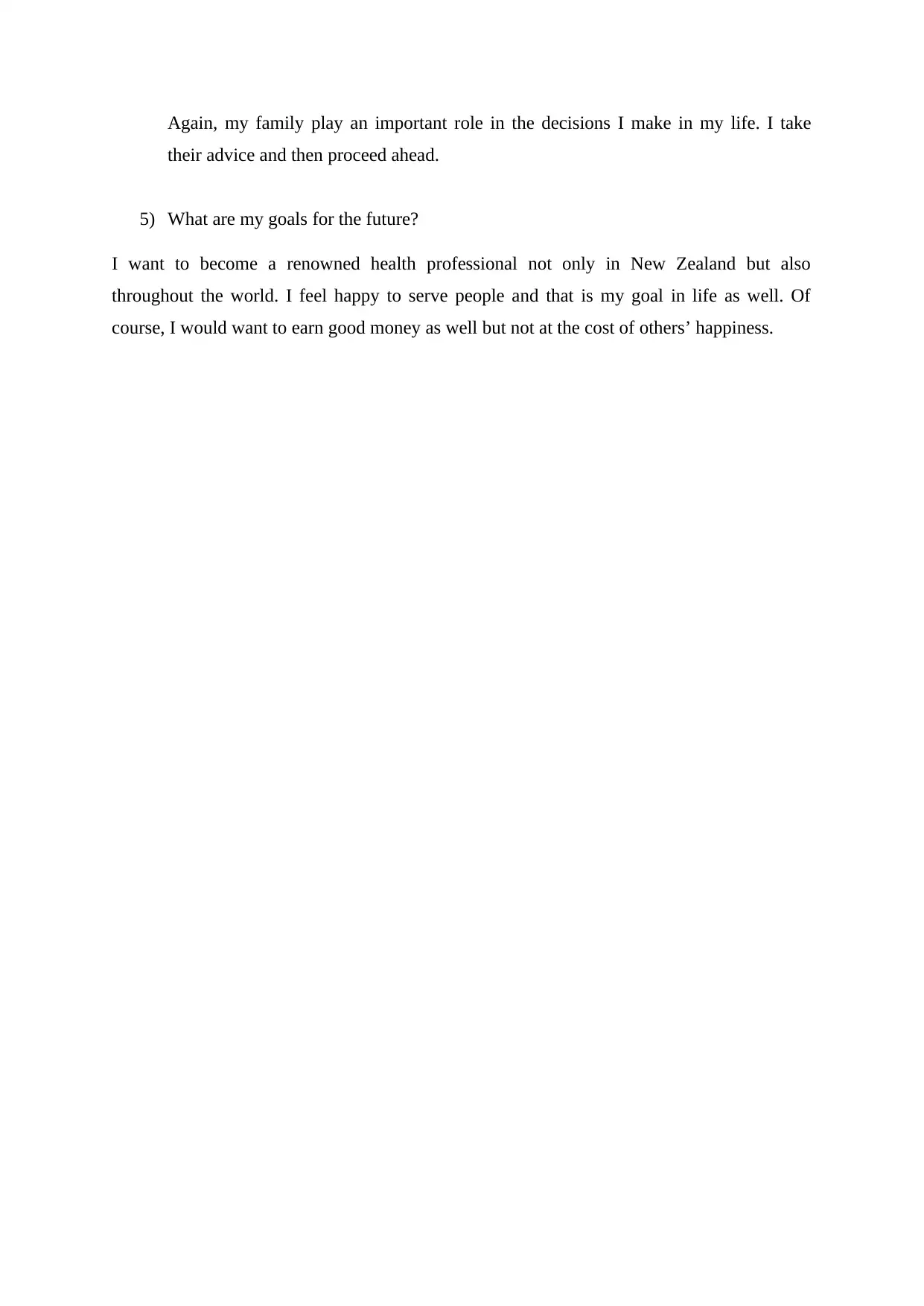
Again, my family play an important role in the decisions I make in my life. I take
their advice and then proceed ahead.
5) What are my goals for the future?
I want to become a renowned health professional not only in New Zealand but also
throughout the world. I feel happy to serve people and that is my goal in life as well. Of
course, I would want to earn good money as well but not at the cost of others’ happiness.
their advice and then proceed ahead.
5) What are my goals for the future?
I want to become a renowned health professional not only in New Zealand but also
throughout the world. I feel happy to serve people and that is my goal in life as well. Of
course, I would want to earn good money as well but not at the cost of others’ happiness.
Paraphrase This Document
Need a fresh take? Get an instant paraphrase of this document with our AI Paraphraser
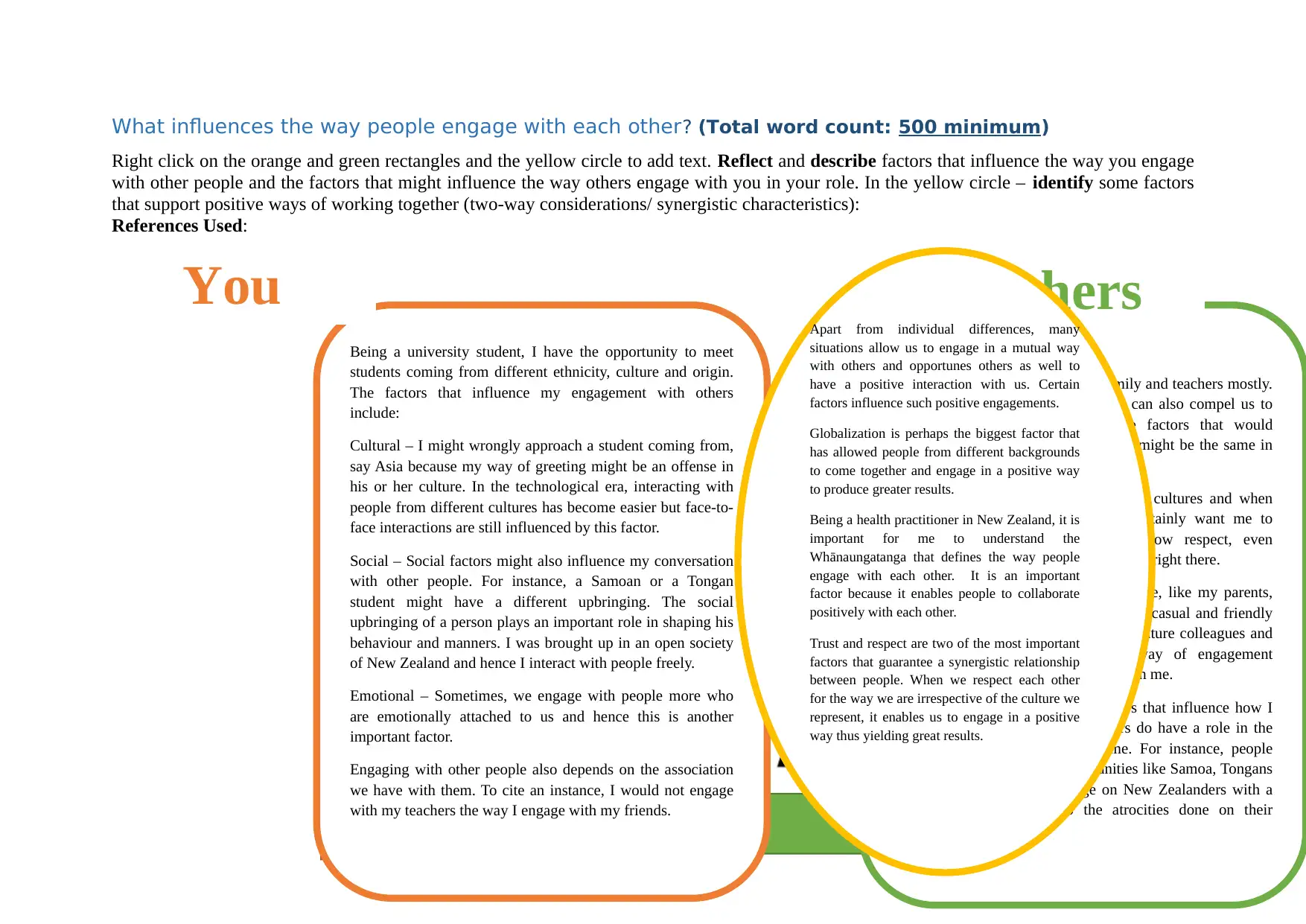
What influences the way people engage with each other? (Total word count: 500 minimum)
Right click on the orange and green rectangles and the yellow circle to add text. Reflect and describe factors that influence the way you engage
with other people and the factors that might influence the way others engage with you in your role. In the yellow circle – identify some factors
that support positive ways of working together (two-way considerations/ synergistic characteristics):
References Used:
Being a university student, I have the opportunity to meet
students coming from different ethnicity, culture and origin.
The factors that influence my engagement with others
include:
Cultural – I might wrongly approach a student coming from,
say Asia because my way of greeting might be an offense in
his or her culture. In the technological era, interacting with
people from different cultures has become easier but face-to-
face interactions are still influenced by this factor.
Social – Social factors might also influence my conversation
with other people. For instance, a Samoan or a Tongan
student might have a different upbringing. The social
upbringing of a person plays an important role in shaping his
behaviour and manners. I was brought up in an open society
of New Zealand and hence I interact with people freely.
Emotional – Sometimes, we engage with people more who
are emotionally attached to us and hence this is another
important factor.
Engaging with other people also depends on the association
we have with them. To cite an instance, I would not engage
with my teachers the way I engage with my friends.
By others, it may be my friends, family and teachers mostly.
Apart from that, chance interactions can also compel us to
engage with unknown people. The factors that would
influence my engagement with others might be the same in
this case well.
Cultural – People come from different cultures and when
they engage with me, they would certainly want me to
respect their culture. If I fail to show respect, even
mistakenly, their engagement would stop right there.
Social – Those socially connected to me, like my parents,
relatives and friends would engage in a casual and friendly
manner. However, my teachers or my future colleagues and
managers would have a different way of engagement
because they are not linked socially with me.
Historical factors – Unlike the factors that influence how I
engage with others, historical factors do have a role in the
way others would interact with me. For instance, people
belonging to the different communities like Samoa, Tongans
or Maoris might have a grudge on New Zealanders with a
British background due to the atrocities done on their
ancestors.
You OthersApart from individual differences, many
situations allow us to engage in a mutual way
with others and opportunes others as well to
have a positive interaction with us. Certain
factors influence such positive engagements.
Globalization is perhaps the biggest factor that
has allowed people from different backgrounds
to come together and engage in a positive way
to produce greater results.
Being a health practitioner in New Zealand, it is
important for me to understand the
Whānaungatanga that defines the way people
engage with each other. It is an important
factor because it enables people to collaborate
positively with each other.
Trust and respect are two of the most important
factors that guarantee a synergistic relationship
between people. When we respect each other
for the way we are irrespective of the culture we
represent, it enables us to engage in a positive
way thus yielding great results.
Right click on the orange and green rectangles and the yellow circle to add text. Reflect and describe factors that influence the way you engage
with other people and the factors that might influence the way others engage with you in your role. In the yellow circle – identify some factors
that support positive ways of working together (two-way considerations/ synergistic characteristics):
References Used:
Being a university student, I have the opportunity to meet
students coming from different ethnicity, culture and origin.
The factors that influence my engagement with others
include:
Cultural – I might wrongly approach a student coming from,
say Asia because my way of greeting might be an offense in
his or her culture. In the technological era, interacting with
people from different cultures has become easier but face-to-
face interactions are still influenced by this factor.
Social – Social factors might also influence my conversation
with other people. For instance, a Samoan or a Tongan
student might have a different upbringing. The social
upbringing of a person plays an important role in shaping his
behaviour and manners. I was brought up in an open society
of New Zealand and hence I interact with people freely.
Emotional – Sometimes, we engage with people more who
are emotionally attached to us and hence this is another
important factor.
Engaging with other people also depends on the association
we have with them. To cite an instance, I would not engage
with my teachers the way I engage with my friends.
By others, it may be my friends, family and teachers mostly.
Apart from that, chance interactions can also compel us to
engage with unknown people. The factors that would
influence my engagement with others might be the same in
this case well.
Cultural – People come from different cultures and when
they engage with me, they would certainly want me to
respect their culture. If I fail to show respect, even
mistakenly, their engagement would stop right there.
Social – Those socially connected to me, like my parents,
relatives and friends would engage in a casual and friendly
manner. However, my teachers or my future colleagues and
managers would have a different way of engagement
because they are not linked socially with me.
Historical factors – Unlike the factors that influence how I
engage with others, historical factors do have a role in the
way others would interact with me. For instance, people
belonging to the different communities like Samoa, Tongans
or Maoris might have a grudge on New Zealanders with a
British background due to the atrocities done on their
ancestors.
You OthersApart from individual differences, many
situations allow us to engage in a mutual way
with others and opportunes others as well to
have a positive interaction with us. Certain
factors influence such positive engagements.
Globalization is perhaps the biggest factor that
has allowed people from different backgrounds
to come together and engage in a positive way
to produce greater results.
Being a health practitioner in New Zealand, it is
important for me to understand the
Whānaungatanga that defines the way people
engage with each other. It is an important
factor because it enables people to collaborate
positively with each other.
Trust and respect are two of the most important
factors that guarantee a synergistic relationship
between people. When we respect each other
for the way we are irrespective of the culture we
represent, it enables us to engage in a positive
way thus yielding great results.

⊘ This is a preview!⊘
Do you want full access?
Subscribe today to unlock all pages.

Trusted by 1+ million students worldwide

1 out of 10
Related Documents
Your All-in-One AI-Powered Toolkit for Academic Success.
+13062052269
info@desklib.com
Available 24*7 on WhatsApp / Email
![[object Object]](/_next/static/media/star-bottom.7253800d.svg)
Unlock your academic potential
Copyright © 2020–2026 A2Z Services. All Rights Reserved. Developed and managed by ZUCOL.





